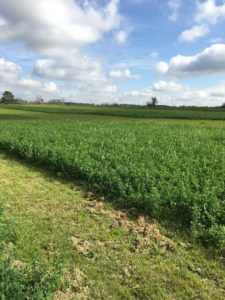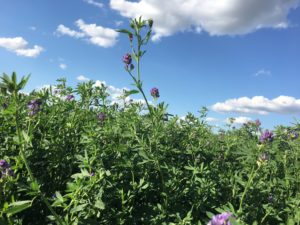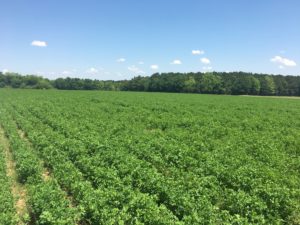Alfalfa in Bermudagrass Checklist
So you want to plant Alfalfa into your Bermudagrass this fall.
Make sure to check our list before getting started!
- Soil Test – Target pH should be 6.5 or greater and subsoil pH (~1 ft below soil surface) should be 5 or greater. Phosphorous (P) and Potassium (K) levels should be in at least the medium range, and micronutrients Molybdenum (Mo) and Boron (B) are very important in Alfalfa production.
- Soil Type – Be sure to select an area with a well-drained, deep, and fertile soil. Avoid areas that tend to hold water for long periods of time. Just like bermudagrass, alfalfa does not like to have “wet feet”. Poor drainage can be detrimental to alfalfa stands.
- Prior Weed Control – Avoid areas that have had broadleaf chemistries with residual soil activity applied within the last year (i.e., GrazonNext and Pastora).
Prior to Planting:
- Secure Seed – Consult your local extension agent and review regional alfalfa variety test results to select a variety suitable for growth in your area. Not all alfalfas are created equal – selecting the right variety for your location is imperative! Purchase seed well in advance of need.

- Apply Fertilizer and Lime – Based on soil test results, apply fertility to keep soil within the recommended ranges. Do not expect lime to increase soil pH in less than 6-8 months.
- Suppress Sod – Bermudagrass should be grazed or mowed very short (1-2 inches) just prior to interseeding with alfalfa. After cutting, spray with a light rate of a non-selective herbicide (glyphosate) to induce dormancy and suppress the bermudagrass sod. This will not kill your Bermudagrass, rather it will induce dormancy (“put it to sleep”). This is a
very important step! If skipped, greater challenges and potential alfalfa stand failures are likely. - Plant – Using a calibrated no-till drill, plant alfalfa directly into bermudagrass sod. Plant no deeper than ½ inch! Alfalfa is a small seed, so err on the shallow side. Stand failures due to improper planting depth are common, especially in sandier soils. Recommended seeding rate of alfalfa is 20-25 lbs/acre, however if interseeding on a wider row spacing (i.e. 14-15 inch vs 7-8 inch) you can decrease the seeding rate to 12-15 lbs/acre.
**Note: Most alfalfa seed comes pre-inoculated, however it is always good to check to make sure prior to planting your material!
After Emergence:
- Insect Pest Management – Immediately after alfalfa emergence, spray with insecticide (i.e. Mustang Max or Karate) to control mole crickets and other insect pests that may damage young alfalfa plants over winter.

- Weed Pest Management – If using an alfalfa with RR technology, use glyphosate as necessary to control winter weeds and re-induce dormancy of bermudagrass in unusually warm winters. Once alfalfa is established, pre-emergent technologies are recommended to help combat common volunteer annual weeds (i.e. annual ryegrass, crabgrass).
Want a one page print out of this checklist? Download our pdf version: SE CATTLE ABG Checklist download
Want to know more about Alfalfa in The South? Be sure and attend our upcoming workshop! Alfalfa in the South Workshop Flyer – Final
Prepared by: J.J. Tucker (UGA), M.K. Mullenix (AU), and D.W. Hancock (UGA)
Funded in part by USDA-NIFA Alfalfa and Forage Grant Research Program Grant #2017-04168
Please follow and like us:

